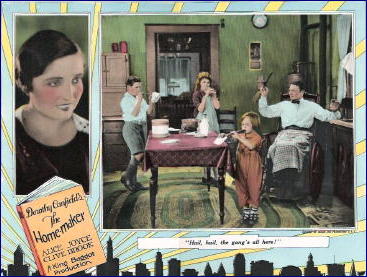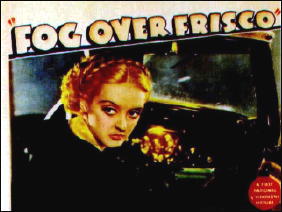April 2011
Monthly Archive
Sat 30 Apr 2011
Posted by Steve under
Reviews[8] Comments
HELENE TURSTEN – Detective Inspector Huss. Soho Crime, hardcover; 1st US printing, July 2003; trade paperback, May 2004. Originally published in Sweden as Den krossade tanghästen, 1998.
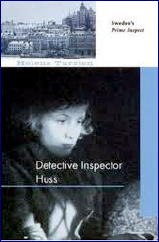
The original title in Swedish, if translated correctly, would be (I believe) The Broken Tang Horse. It was changed, I suspect, for two reasons. The first I won’t tell you, but I think the second was to more correctly focus on what this novel is about: namely Detective Inspector Irene Huss.
While portions of the book are told from the point of view of some of her fellow members of the Göteborg Homicide Division, most of this crime procedural novel is from hers. She’s in her forties, or so was my impression, happily married (her husband seems entirely comfortable with her career while he works as a chef), with two twin daughters in their early teens, one of whom decides halfway through the book to become a Skinhead and sing in a neo-Nazi rock band.
This causes some friction at home, to say the least, and it takes an Intervention dinner with one of Irene’s colleagues to shock some sense into her. Irene’s other problems include working too many hours, drinking too much coffee, eating too much pizza, and having violent encounters with the Swedish version of the Hell’s Angels.
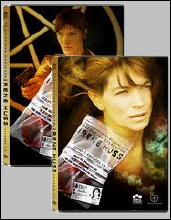
The case itself, in this the first of which that have been recorded, is a major one and involves the death by falling of a wealthy businessman from the upper floor of his majestic palace of a home. Was it an accident? Suicide? Neither. It is quickly concluded that it was murder, and significantly over 350 pages of small print follow.
The story takes place near Christmas time, so the weather is cold, sloppy, dreary and cold, and the investigation is slow, methodical (plodding) but effective. But once again, the focus is on Detective Huss and the fellow members of her squad and their boss, Superintendent Sven Andersson, who is older and ill-equipped to manage the idiosyncrasies of detectives on his team, all well drawn and easily recognized as strong-willed individuals, both male and female.
The case itself, while multi-faceted and one that leads to all levels of Swedish society as well as several other deaths, is cracked by keeping tabs on a set of keys – who had extras made, who had access to them, and who had them.
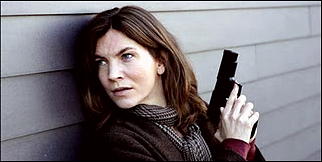
It took me several evenings of spare time reading to steadily make my way to the end. I wasn’t caught up with this one as much as I have been with the Stieg Larsson books, but I’m looking forward to catching up with more of Detective Huss’s adventures, or at least I would be if more of them could be found translated into English. Only three of them have been, so far:
· 1998 – Den krossade tanghästen, English title: Detective Inspector Huss (2003)
· 1999 – Nattrond
· 1999 – Tatuerad torso. English title: The Torso (2006)
· 2002 – Kallt mord
· 2002 – Glasdjävulen. English title: The Glass Devil (2007)
· 2004 – Guldkalven
· 2005 – Eldsdansen
· 2007 – En man med litet ansikte
· 2008 – Det lömska nätet
· 2010 – Den som vakar i mörkret
[UPDATE] 05-01-11. I’ve just added the images you see above. For information on the Swedish television series based on the Inspector Huss books, see the comments.
Sat 30 Apr 2011
REVIEWED BY GEOFF BRADLEY:
AGATHA CHRISTIE’S POIROT. ITV [UK]. Season Eleven: 01 through 22 September 2008. Hercule Poirot: David Suchet, Adriadne Oliver: Zoe Wanamaker.
At least this is how the title of this [four] part series (2 hours each, less adverts) was given in the Radio Times. On screen it appeared to be the less grammatical Agatha Christie Poirot.
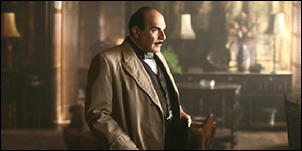
First up was “Mrs. McGinty’s Dead.” This is workaday rather than top class Christie, and I had one or two quibbles about the “red herrings” which relied a little too much on coincidence. But the adaptation was well done, and I enjoyed the production greatly. The part of Adriadne Olliver was played very well by Zoe Wanamaker.
Second was “Cat Among the Pigeons.” I haven’t read this book, but looking at references, the producers have made a few slight changes, first to have Poirot on hand at the start and secondly to “sanatise” the sub-plot. Rather like the previous episode this was a very enjoyable production which I enjoyed despite what I perceived as flaws in the plot.
Third was “Third Girl,” in which Zoe Wanamaker returns as Ariadne Oliver. Again not the strongest of stories, and I think it’s fair to say that as this series goes, the best is not still to come. Still I found it quite watchable despite its obvious weaknesses.
— Reprinted from Caddish Thoughts #134, November 2008.
Editorial Comments: Not included in Geoff’s review at the time was Episode 4: “Appointment with Death.” There has been one further season of four additional episodes, making 65 so far with David Suchet as Poirot. The most recent episode to date has been “Murder on the Orient Express,” which aired 11 July 2010. It has been reported that a 13th and final series is scheduled for production in 2011.
Sat 30 Apr 2011
Posted by Steve under
ReviewsNo Comments
REVIEWED BY TINA KARELSON:
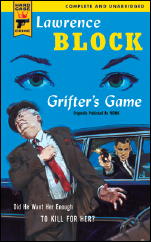
LAWRENCE BLOCK – Grifter’s Game. Hard Case Crime, paperback, September 2004. Originally published as Mona, Gold Medal s1085, paperback original, 1961. Also: Carroll & Graf, pb, 1994; Five Star, hardcover, 1999.
Joe Marlin is a con man, small-time thief and borderline gigolo. He lives a detached, drifting life, spending most of his time in nice hotels with plenty of liquor and willing, vacationing women — as well as the relative novelty of air conditioning.
After he falls hard for Mona Brassard, everything changes. Without giving anything else away, the writing is only workmanlike, but this book has one of the most brutal, psychologically horrifying conclusions ever — without a drop of blood being spilled.
Editorial Comment: My own review of Mona appears here earlier on this blog. From what I read now of what I wrote then, some 32 years ago, I had the same reaction to the ending as Tina has.
Sat 30 Apr 2011
REVIEWED BY WALTER ALBERT:
THE HOME MAKER. Universal, 1925. Alice Joyce, Clive Brook, Billy Kent Schaefer, Martha Mattox, Virginia True Boardman, Jacqueline Wells (later known as Julie Bishop). Scenario by Mary O’Hara, from the novel by Dorothy Canfield. Director: King Baggot. Shown at Cinecon 44, Hollywood CA, Aug-Sept 2008.
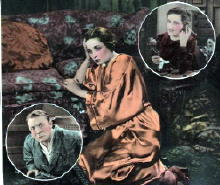
The subject of this film — a reversal of roles in which the husband stays home and takes care of the children — was probably an unusual one in 1925, one that was apparently reflected (according to reviews quoted in the program notes) in the hostility in at least some of the reviews to the husband’s role.
He’s portrayed as almost terminally bored by his office job and when he’s passed over for a promotion and then, as in everything else, fails at a suicide attempt that leaves him a cripple, he welcomes the opportunity to stay at home while his wife, taking a low-level job in the womens’ wear factory run by his former company, quickly shows herself to be a gifted manager, soon promoted to a position and salary her husband could only have dreamed of.
This domestic drama might initially seem to have been lifted from the pages of one of the slick womens’ magazines of the period, but it sheds that formulaic corset, impressing by its crisp direction, fine acting and unsentimental treatment of a then controversial subject.
It should be noted that two distinguished women writers were credited for the source and scenario for the film. Dorothy Canfield (Fisher) is probably best known for her children’s classic Understood Betsy, while Mary O’Hara was the author of the bestselling My Friend Flicka, turned into a successful film by MGM starring Roddy MacDowell (and, of course, a horse).
Fri 29 Apr 2011
REVIEWED BY DAN STUMPF:
GEORGE DYER – Five Fragments. Houghton Mifflin, hardcover, 1932. Hardcover reprint: Grosset & Dunlap, 1932 [?].
Film: FOG OVER FRISCO. First National Pictures, 1934. Bette Davis, Donald Woods, Margaret Lindsay, Lyle Talbot, Hugh Herbert, Arthur Byron, Robert Barrat, Henry O’Neill, Irving Pichel, Douglass Dumbrille. Director: William Dieterle.
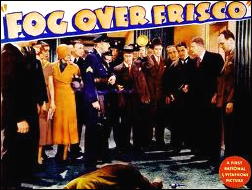
Following Dolores Hitchens’ Fools Gold [reviewed here ] and still on the book-to-movie bent, I visited a novel called The Five Fragments by George Dyer.
Dyer authored a series of mysteries in the 1930 centered around the Catalyst Club, but this ain’t one of ’em; it’s a Keeler-esque series of long narrative flashbacks framed by a mysterious host who has assembled a group of disparate guests, each of whom knows something about a recent and notorious murder/kidnapping scandal in San Francisco.
The five narrators — a pretty standard set of stock characters including a dumb cop, brash young reporter, doughty coast-guardsman, colorful gangster and cool customs agent — proceed to sketch out a tale of dope smuggling, bootleggers, a wild heiress named Arlene and her half-sister, who has fallen in love with the reporter and then got herself kidnapped.

The resultant surprise conclusion is a bit creaky but entertaining nonetheless, and though none of the characters is ever more than two-dimensional, they are at least painted up real pretty, and they go through their allotted paces at a brisk clip.
When Warners filmed this in 1934 as Fog Over Frisco they chewed through the book typical abandon: jettisoned the framing device, added a bumbling photographer (Hugh Herbert) to follow the brash young reporter and provide dubious comedy relief, switched stolen bonds for smuggled drugs (a bit of a no-no in ’34) and threw in a sinister butler for good measure.
But I especially like what they did with the Arlene character, who never actually appears in the book: they built the non-existent part up into a neatly bitchy role for top-billed Bette Davis, who clearly relishes the part and leaves the movie all too soon.
Directed by William Deiterle at the usual break-a-leg pace Warners’ pace, Fog offers nothing too special, but serves it up well.
Fri 29 Apr 2011
A 1001 MIDNIGHTS Review
by Edward D. Hoch
ÉMILE GABORIAU – Monsieur Lecoq. E. Dentu, Paris, 1868. Edited version published in the US: Dover, softcover, 1975.
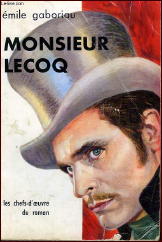
Monsieur Lecoq, Gaboriau’s twelfth book and his fifth novel in which the French detective of the title appears, is today often considered his best and most readable book. Changing reading habits, plus indifferent translations, have left the pioneer French mystery writer all but unread today, but he deserves a place in any survey of classic detective fiction.
Lecoq, introduced in his first book as a secondary character, was a minor Sûreté detective with a shady past somewhat like the real-life Vidocq. But he soon takes center stage in the Gaboriau novels, and in Monsieur Lecoq he investigates a triple murder in a poor section of Paris.
The killer, apprehended at the scene, appears to be a petty criminal who calls himself May, but Lecoq suspects he might really have another identity. The duel of wits between the two men extends through the first volume of the novel.
The second volume, sometimes published separately as The Honor of the Name, is really a separate and inferior historical novel set around the year 1815, with Lecoq and the evasive villain only reappearing in the final twenty-two pages.
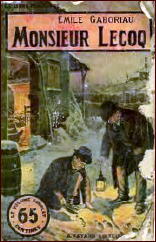
Though there have been numerous British and American editions of the novel, the recent Dover edition cited above (skillfully edited and introduced by E. F. Bleiler) is the first to eliminate the extraneous historical novel and jump at once from the end of volume one to the important final pages of volume two.
Gaboriau’s books are not without their weaknesses, and they often suffer from cardboard characterization and inconsistencies. Their strengths lie in plotting and background. They are not exactly the books we think of as detective novels today, but enough elements are present to argue effectively that Gaboriau deserves his title as the father of the detective novel.
Lecoq first appears as a secondary character in The Widow Lerouge (1866), but stars in his next two cases, The Mystery of Orcival (1867) and File No. 113 (1967). He also makes a brief appearance in The Slaves of Paris (1868), but this is more a crime novel than a detective story.
———
Reprinted with permission from 1001 Midnights, edited by Bill Pronzini & Marcia Muller and published by The Battered Silicon Dispatch Box, 2007. Copyright © 1986, 2007 by the Pronzini-Muller Family Trust.
Thu 28 Apr 2011
Posted by Steve under
Reviews[12] Comments
BRUNO FISCHER – House of Flesh. Gold Medal #123, paperback original, 1950. Reprinted several times.
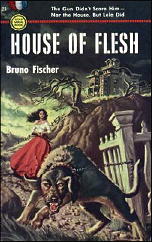
Here’s a book whose main thesis is that the female of the species is a preying mantis, capable of devouring the male in the very act of sex; a she-dog in heat, contemptuously amused at the howls of the horde of disappointed hounds pawing furiously the door. (I grant you, some of you are not going to need to know anything more.)
Harry is a professional basketball player from New York, seeking a summer of recuperation in the outlying countryside. Lela is the wife of the local veterinarian. Rumor has it that he fed his first wife to the dogs, and thereby hangs the tale: a detective story — truly it is! — a rich, sultry one with the sort of down-to-earth appeal that made the early Gold Medal paperbacks so immediately and immensely profitable.
Images of a certain kind or a rustic America in a certain indefinite time in its past should spring to mind. These pictures of an age largely past may be entirely a matter of fiction, nothing more than a state of the imagination, and may have always been so, but their lush moodiness can be sharply cutting as well, with the moment of incision preserved in an instant forever.
The dogs provide an essential clue to the murder that Harry is eventually accused of, but you know as well I do what comes before then: “Undress me … but slowly … very slowly …”
House of Flesh was Fischer’s first for Gold Medal in their series of paperback originals that took the country by storm, and it was reprinted several times during the decade that followed.
Rating: B plus.
— Reprinted from The MYSTERY FANcier, Vol. 3, No. 6, Nov/Dec 1979 (slightly revised).
[UPDATE] 04-18-11. The closet in my upstairs study has a shelf where I keep my Gold Medal paperbacks from this era, about a thousand of them. It’s time I started to read them again. I don’t remember any of the specifics of this one, but what I had to say back then about House of Flesh certainly triggers off a huge carload of memories.
Thu 28 Apr 2011
A 1001 MIDNIGHTS Review
by Marcia Muller
FRANCES CRANE – Death-Wish Green. Random House, hardcover, 1960. Hardcover reprint: Detective Book Club, 3-in-1 edition. No paperback edition.
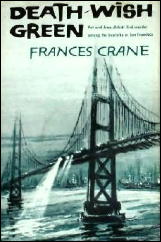
Pat and Jean Abbott, a private investigator and his wife, are returning to foggy San Francisco from a weekend in the sun. As they reach the toll plaza of the Golden Gate Bridge, they spot a familiar car being inspected by highway patrolmen and the local police. The car, which was abandoned on the bridge, belongs to Katie Spinner, daughter of friends of the Abbotts; and it appears she has jumped off the bridge.
Jean Abbott, however, is not convinced the girl committed suicide; and when Pat is hired by Katie’s aunt to investigate the disappearance, it becomes apparent Katie is still alive.
The Abbotts, who often work as an investigative team, focus on bohemian North Beach, one of the last places Katie was seen before she started across the bridge. There they encounter an art-gallery dealer with a taste for Zen Buddhism and opium; a model who calls her favorite color “death-wish green,” and dies wearing it; a mysterious stranger with a large auburn beard who was seen with the missing girl in a coffeehouse; and errant sons and daughters of some of the city’s wealthiest and most respected families.
For all Pat Abbott’s investigative skills, in the end it is Jean who sees most of the action and carries the day.
Frances Crane’s descriptive powers are considerable, and the sense of place — particularly of the fog and its effect on San Francisco — is powerful. Her secondary characters are well drawn and indeed far more vividly drawn that either Pat or Jean. Jean, the narrator/observer, remains just that, and we come away without really having gotten to know her. Pat, the detective, is merely a figure going through investigative motions.
Frances Crane has written many other novels, all of them with colors in their titles, featuring the Abbotts. Among them are The Amethyst Spectacles (1944), The Buttercup Case (1958), and The Amber Eyes (1962).
In addition to San Francisco, they are set in such locales as Tangier (The Coral Princess Murders, 1954); New Mexico (Horror on the Ruby X, 1956); and New Orleans (The Indigo Necklace, 1955).
———
Reprinted with permission from 1001 Midnights, edited by Bill Pronzini & Marcia Muller and published by The Battered Silicon Dispatch Box, 2007. Copyright © 1986, 2007 by the Pronzini-Muller Family Trust.
Previously on this blog:
The Cinnamon Murder (reviewed by Steve Lewis)
Wed 27 Apr 2011
ONLY IF YOU LIKE IT (THE GOLDEN AGE) ROUGH:
A REVIEW OF THE ROUGH GUIDE TO CRIME FICTION
by Curt J. Evans
BARRY FORSHAW – The Rough Guide to Crime Fiction. Rough Guides, softcover, July 2007.
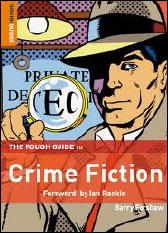
The Penguin Group’s Rough Guides to literature is a smartly-presented series of pocket-sized guidebooks chock full of easily digested information on various literary genres. Barry Forshaw, who edits the Crime Time website, produced The Rough Guide to Crime Fiction [RGTCF], the series’ take on the mystery genre.
While this particular guide definitely has its virtues and can be recommended, the helpful reviewer (especially at a website like Mystery*File) must include a considerable caveat: the coverage of the Golden Age leaves quite a bit to be desired. Dare I say, it’s a bit rough?
The back of the RGTCF notes that “this insider’s book recommends over 200 classic crime novels and mystery authors.†By my count, 248 crime novels are independently listed, along with 21 authors who are specially highlighted. The first book listed was published in 1899, the last in 2007. Thus the 248 books are drawn from a time span of nearly 110 years. Here is how the nearly eleven full decades are represented:
1899-1909 3 books
1910-1919 3 books
1920-1929 4 books
1930-1939 12 books
1940-1949 14 books
1950-1959 11 books
1960-1969 10 books
1970-1979 9 books
1980-1989 16 books
1990-1999 25 books
2000-2007 141 books
Notice anything slightly out of balance here? Perhaps that 57% of the books listed come from the last decade? Or that two-thirds (67%) of the books were published after 1989? Or that 4% of the books come from the first thirty years, 1899-1929?
Barry Forshaw writes in his preface that his Rough Guide “aims to be a truly comprehensive survey, covering every major writer….It covers everything from the genre’s origins and the Golden Age to the current bestselling authors, although a larger emphasis is placed on contemporary writers.†This is a bit of an understatement, perhaps.
I would have no objection to this selective coverage, but for the fact that the book is offered as a “truly comprehensive survey†of this 109 year period. Let’s look at how the earlier decades, particularly those of the Golden Age, are covered, shall we?
First it should be noted that the listed books are divided into fifteen sections. It’s a mite confusing, since some are chronological, more or less, and some go by subject:
1. Origins
2. Golden Age
3. Hardboiled and Pulp
4. Private Eyes
5. Cops
6. Professionals
7. Amateurs
8. Psychological
9. Serial Killers
10. Criminal Protagonists
11. Gangsters
12. Class/Race/Politics
13. Espionage
14. Historicals
15. “Foreignâ€
You can see immediately how there is potential for overlap—and there often is (Hardboiled/Private Eyes). Then there are places where there isn’t any such overlap, though one would have expected it — Golden Age and Amateurs, for example.
The Golden Age was the Age of the Amateur, surely, yet the Amateurs chapter lists twenty books, only one from before 1957 (G. K. Chesterton’s The Innocence of Father Brown) and, indeed, only three (including Innocence) from before 1992.
Similarly, one might have thought that in the Historicals chapter there might have been room for Agatha Christie’s Death Comes as the End (set in ancient Egypt), John Dickson Carr’s The Devil in Velvet (set in Jacobean England), Josephine Tey’s investigative The Daughter of Time (concerning Richard III and the murder of the princes in the Tower) or one of the collections of Lilian de la Torre’s Dr. Samuel Johnson short stories; yet, no, of the 22 listed books, only three come from before 1990, and these are all between 1978 and 1985 (Ellis Peter’s A Morbid Taste for Bones, Peter Lovesey’s The False Inspector Dew and Julian Rathbone’s Lying in State).
It comes to appear that the later chapters mostly exist to provide more opportunities for listing more current authors. Indeed, one could rightly wonder, after reading this book, why the decades of the 1920s and 1930s are considered a “Golden Age†at all. The real Golden Age would seem to have dawned with the new millennium in 2000.
Only thirteen books are listed for the Golden Age:
Margery Allingham, The Tiger in the Smoke
Nicholas Blake, The Beast Must Die
Christianna Brand, Green for Danger
John Dickson Carr, The Three Coffins
Agatha Christie, Murder on the Orient Express
Edmund Crispin, Love Lies Bleeding
Erle Stanley Gardner, The Case of the Turning Tide
Patrick Hamilton, Hangover Square
Geoffrey Household, Rogue Male
Francis Iles, Malice Aforethought
Ngaio Marsh, Surfeit of Lampreys
Dorothy L. Sayers, Gaudy Night
Josephine Tey, The Franchise Affair
Again there is confusion. Is the Golden Age a period or a style? If a style, what are Hangover Square and Rogue Male doing there (couldn’t the one go in psychology, say, and the other espionage)? If a period, why do three of the books come from after the end of World War Two? Does Forshaw view the Golden Age as having lasted into the early 1950s — if so, why? It would have been nice to have some more depth here.
But, more important, Forshaw’s collection of Golden Age book listings seems ever so paltry. It will be recalled that fully 200 of the 248 listed books in RGTCF come from after the 1950s. Where are British writers like R. Austin Freeman (he’s not in Origins either), Freeman Wills Crofts, H. C. Bailey, Michael Innes, Cyril Hare and Gladys Mitchell?
And, damn it, where in hell are the bloody Americans?! It’s rather eccentric to find (if we discount John Dickson Carr) only one American, Erle Stanley Gardner — and this not for a Perry Mason but rather a 1941 Gramps Wiggins tale. In this book you will not find listings for Melville Davisson Post, Earl Derr Biggers, S.S. Van Dine, Ellery Queen, Rex Stout, Mary Roberts Rinehart or Mignon Eberhart.
One might almost conclude that the United States did not exist in the 1920s and 1930s, but for the presence of a slew of hardboiled novels by the usual suspects (Chandler, Hammett, James M. Cain, W. R. Burnett, etc.).
In a moment I found quite regrettable indeed, Forshaw writes: “The superficial ease of churning out potboilers attracted many hacks, such as the prolific but now little read Ellery Queen.†I am utterly baffled by this statement. How anyone who has read “Ellery Queen†in his best period, from the thirties to the fifties, can deem him a “hack†is beyond me (events after 1960, when the Ellery Queen name was loaned out, admittedly are more problematic).
If Forshaw thinks writing books like The Greek Coffin Mystery and Cat of Many Tails was easy, he should turn his hand to mystery writing immediately, because he must surely be a creative genius of the first order.
It’s emblematic of the low standing to which Ellery Queen has fallen that “he†could be treated in such a way. Not only were the cousins behind Ellery Queen (Frederic Dannay and Manfred Lee) great genre writers, they were most generous men who did much to promote mystery writing and genre scholarship. To me it seems rather a shame for a writer following in their footsteps to dismiss them in such a cavalier manner.
There are other omissions of which one could complain. No mention is made of Edgar Wallace and Sax Rohmer — hugely important figures in the history of the English thriller (they were even “bestsellers,†just like John Grisham, who is included here). They could easily have been fitted into the Criminal Protagonist or Gangster chapters.
Philip MacDonald is omitted, even though his brilliant Murder Gone Mad most certainly belongs among the Serial Killer tales.
Margaret Millar and Celia Fremlin are omitted in the Psychology chapter (and everywhere else, for that matter). To be sure, they are not as well-known today as Patricia Highsmith (listed for Strangers on a Train and with a separate info-box for her Ripley series), but they did fine work that influenced other writers in the 1950s though the 1970s and merited inclusion in a collection of nearly 250 books.
Julian Symons, the important and influential mid- to late-20th century crime novelist and mystery critic, is omitted as well; as are Symons’ excellent contemporaries, Michael Gilbert and Andrew Garve.
In the Origins chapter, Forshaw gives brief nods to Edgar Allan Poe, Charles Dickens and Wilkie Collins, but ignores Mary Elizabeth Braddon, Mrs. Henry Wood and Anna Katharine Green. These three women are in my view inferior to the three men, but they certainly should have been mentioned at least. (They have been subjects of quite a lot of academic scholarship of late.)
Many (though not all) of the omissions I suspect can be explained by the fact that the omitted authors were out of print when Forshaw was writing his Rough Guide. And that’s perfectly fine, really, but I think this point should have been conceded up front for the benefit of the less experienced readers who presumably are the Rough Guide’s target demographic, for such innocent neophytes may be considerably misled, with potentially baneful results, in that they will not learn of many good writers or not see good writers at their best.
Ruth Rendell, for example, gets three listings, all for three novels published after 2000. I have read two of them, The Babes in the Wood and The Rottweiler, and in my view they are in no way anywhere comparable to the author’s best work from, say, 1975 to 1995. Where in the world, for example, is A Dark-Adapted Eye or A Demon in My View or A Fatal Inversion?
Similarly, P. D. James gets a listing for The Murder Room and H. R. F. Keating for Breaking and Entering, both post-1999 novels and simply not their best work. (In a separate entry for P. D. James, Forshaw lists “the top five Dalgleish books†— confusingly this list omits the one James book with a full entry, The Murder Room, while including Innocent Blood, a suspense novel in which Dalgleish never appears.)
I have probably sounded quite rough on this Rough Guide, but it does have its rough patches. Nevertheless, the book has merit, especially for people mainly interested in recent crime fiction (especially that published between 2000 and 2007), for whom I think it can be recommended without qualification. There the coverage truly does appear to be “truly comprehensive.â€
I also should mention that I particularly enjoyed the Espionage chapter and that I thought Forshaw’s treatment of Hardboiled books superior to that which he gave the Golden Age detective novel. Perhaps the Golden Age needs a Rough Guide all its own!
Wed 27 Apr 2011
Posted by Steve under
ReviewsNo Comments
TWO REVIEWS BY FRANCIS M. NEVINS:
GEORGES SIMENON – Maigret and the Black Sheep. Harcourt Brace Jovanovich, hardcover, 1976. Hardcover reprint: Detective Book Club, 3-in-1 edition. Harvest Books, paperback, 1983.
NICOLAS FREELING – The Bugles Blowing. Harper & Row, hardcover, 1975. Vintage Books, paperback, 1980.
Jules Maigret and Henri Castang both work for France’s Police Judiciaire, but any similarity between the two stops there. Maigret, that great-hearted bear of a man, larger than life, patiently sucking on his pipe or sipping a calvados in the local brasserie while he absorbs the atmosphere, was created by Georges Simenon in 1931 and appeared regularly until the author’s retirement in 1972.
Castang, an efficient if featureless cog in the investigative bureaucracy of an unnamed provincial city, is the newest creation of Nicolas Freeling, whose better known series character was the late Inspector Van Der Valk of the Amsterdam police. Put together the new Castang novel and a recently translated Maigret, and you have a measure of how the European police novel has evolved over the past few years.
Maigret and the Black Sheep first appeared in France in 1962, but from internal detail, it might as easily date from 1932 or 1952. The murder of a retired cardboard-box manufacturer in a middle-class Montparnasse apartment building brings Maigret into confrontation with the dead man’s wife, daughter and son-in-law, all three of whom seem to Maigret to be hiding something.
His efforts to penetrate their common secret take the form of foot-slogging routine rather than the usual near-mystical osmosis by which he blends into his surroundings until he comprehends them. The book as a whole, though smooth to read, lacks the substance and bite of the best Maigrets and seems almost like a work of the 19th cnetury when compared with Freeling.
The Bugles Blowing opens on a stifling Sunday afternoon with a government official’s phoned conversation with Castang that he has just walked into an orgy involving his wife and teen-age daughter and the artist who was painting the wife’s portrait.
He has killed all three. The murderer’s high position leads everyone to expect a whitewash, a plea of temporary insanity followed by a brief sentence to a country-club psychiatric institution. But this killer seems obsessively determined to force the government to execute him.
The movement of the story is ponderous, painfully precise, like the French criminal justice system which is the subject, and Freeling captures both the nobility and nonsense in the ritual behavior of the system’s functionaries. Without suspense or surprise, we are made to march to the gallows with a murderer whose execution becomes more unthinkable and more inevitable with each chapter.
The strength of this novel lies ints slow accumulation of details — legal, literary, culinary and sheerly human — reflecting countless aspects of French life, including the polarization caused by the Arab-Israeli conflict and the existence of a number of professional terrorists used by the government for political assassinations. One would never find such a wealth of contemporary minutiae in the classically uncluttered policiers of Simenon.
When a British police officer in The Bugles Blowing speaks of those “awful Maigret books in which the French policemen become exceptionally sharp after about four Pernods,” he may or may not be speaking for Freeling. But there is definitely a new form of European sensibility at work in the police novel, and readers for a taste for it will not want to forget Freeling or Castang.
— Reprinted from
The MYSTERY FANcier, Vol. 1, No. 5, September 1977.
Next Page »






